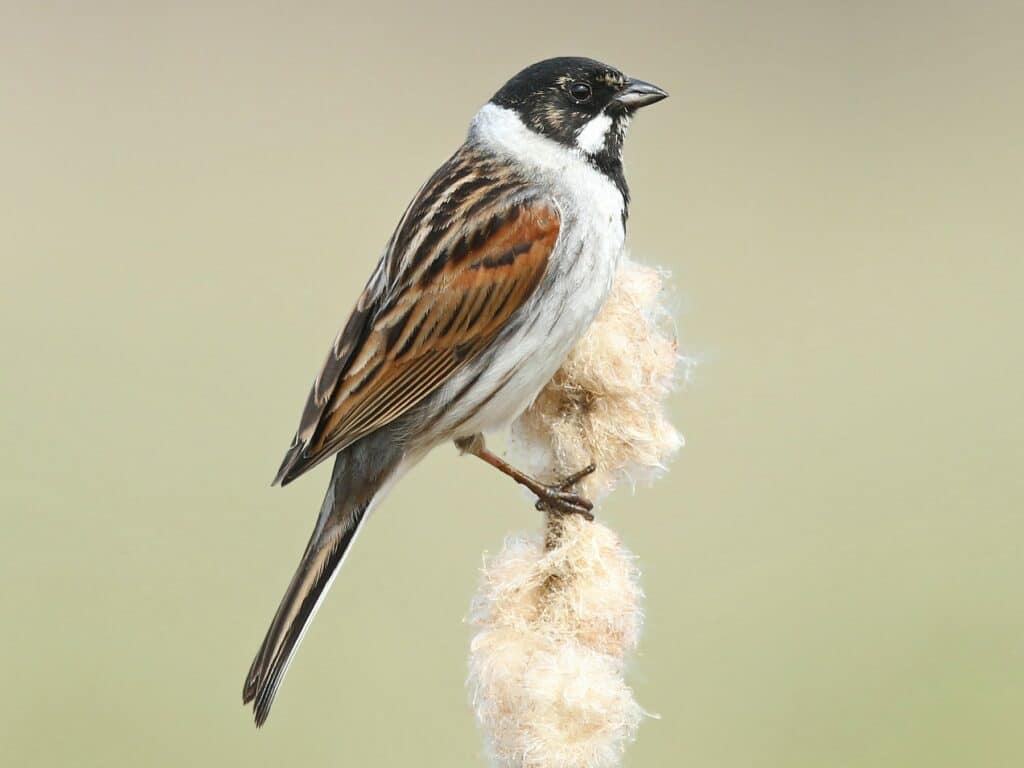The Reed Bunting, a small bird species, presents a fascinating study in avian behaviour, ecology, and conservation. This article delves into its distinctive characteristics, habitat preferences, reproductive cycle, dietary habits, and the threats it faces from predators. Further, we explore the Reed Bunting’s significant contributions to maintaining ecosystem balance. This comprehensive insight provides a deeper understanding of this often-overlooked bird species and its vital role in our natural world.
Understanding the Reed Bunting’s Appearance
The species is known for its striking plumage, which displays considerable variation. The males, especially, feature bold black and white patterns, typically accentuated during the breeding season. These variations in plumage are not merely aesthetic but serve significant roles in the Bunting migration patterns. These patterns act as camouflage, protecting them during their extensive seasonal migrations. Also, their physical attributes, including a robust body and strong wings, aid them in enduring long migratory journeys. Thus, understanding the Reed Bunting’s appearance extends beyond mere observation, revealing intricate connections between its physical characteristics and survival strategies.

Habitat Preferences of the Reed Bunting
The Reed Bunting, a bird adept at adapting, exhibits a marked preference for wetland habitats but can often be found in farmland and woodland environments. This versatile species has been observed adjusting its habitat preferences per the Bunting Migration Patterns. During breeding, they predominantly inhabit reed beds and marshes, displaying a significant seasonal adaptation. When reed beds are less available in the winter, they shift to farmlands and woodlands to find food and shelter. This shift in habitat not only highlights the Reed Bunting’s resilience but also underscores its adaptability. These Seasonal Adaptations ensure the species’ survival amidst changing environmental conditions and available resources.
The Reproductive Cycle of Reed Buntings
While Reed Buntings are known for their adaptability in shifting habitats, they also exhibit a fascinating reproductive cycle that is closely intertwined with the changing seasons. Mating rituals commence in the early spring, marked by the males’ vibrant plumage and distinctive song. The male’s performance serves as both a territorial claim and a lure for potential mates. Following successful courtship, nest construction begins. Preferred locations are dense, low-lying vegetation near water bodies, providing cover from predators. The female primarily builds the compact, cup-shaped nest, using grasses, leaves, and moss. This phase is critical for the survival of the clutch. The reproductive cycle of Reed Buntings, therefore, is a delicate balance of courtship, territorial dominance, and careful nest construction.
Reed Bunting’s Diet and Predators
Predominantly insectivorous during the breeding season, their diet shifts to seeds in winter, aligning with Bunting Migration Patterns. Predators such as foxes, weasels, and birds of prey pose a significant threat to their survival.
Reed Buntings have developed unique defensive strategies. According to a Bunting Vocalization Study, their calls alert others of impending danger, simultaneously confusing predators. Furthermore, their migratory patterns, often dictated by food availability and predator presence, significantly influence their diet and predator interaction. Thus, understanding Reed Bunting’s diet and predators is vital to comprehending their life cycle and developing effective conservation strategies.
The Role of Reed Buntings in Ecosystem Balance
Contributing significantly to ecosystem balance, Reed Buntings carry out the critical function of controlling insect populations during their breeding season. Their feeding habits help to keep these populations in check, preventing the overpopulation of certain species and promoting biodiversity. Additionally, their Bunting Migration Patterns directly impact various ecosystems across their migratory routes. As they travel, these birds disperse seeds from the plants they feed on, aiding plant propagation. This process, in turn, plays a vital role in pollination, indirectly supporting the growth of various plant species. Through these activities, Reed Buntings help maintain a balanced ecosystem, demonstrating the interconnectedness of species and the importance of each one’s role in preserving environmental stability.
Conclusion
In conclusion, with its distinctive appearance, the Reed Bunting plays a significant role in maintaining ecological balance. Its habitat preferences, diet, and reproductive cycle contribute to its survival despite predator threats. Understanding these aspects of the Reed Bunting provides valuable insights into its behaviour, survival strategies, and the intricate balance of its inhabitable ecosystem. Continuous research on these birds will aid in their conservation and ensure they continue to thrive.

Ash is a contributing author who has been writing about wildlife for as long as he can remember. He has a vast knowledge of many different types of animals, from the tiniest shrews to the great whales that live in the deepest oceans.
